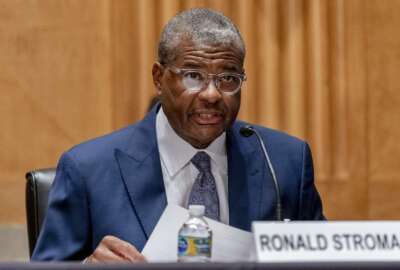Postal hiring reform helped, but there’s more work to do
The Postal Service managed to cut hiring times thanks to some reforms back in 2019. But for thousands of job postings, it gets no applicants.
The Postal Service managed to cut hiring times thanks to some reforms back in 2019. But for thousands of job postings, it gets no applicants. Those are among the top findings of an audit by the Postal Inspector General. For details, the Federal Drive with Tom Temin spoke with the Deputy Assistant IG for Finance, Pricing and Human Capital, Alan MacMullin.
Interview Transcript:
Tom Temin So you studied reform that actually started in 2019 for the Postal Service. What were they trying to accomplish and what’s happened in the intervening years?
Alan MacMullan The Postal Service was aiming to kind of streamline its hiring process and reduce the time to hire. And they took some pretty significant steps back in, like as you mentioned in 2019. And so, our audit was looking at how successful those steps were. Through the course of our scope, period was fiscal year 21 to 2023.
Tom Temin And in that period, how many people did they hire and what were the hiring time? Delta between 2019 and say that more recent hires?
Alan MacMullan Yeah. So, we found that the steps that they took were pretty successful. And when they are able to identify candidates, they can bring them on very quickly. And so, we saw a significant reduction in hiring time over the scope period. They reduced it by almost 35%. And most recently from time that the job announcement is posted to when they can get the employee officially on the record is about 30 days.
Tom Temin So that’s almost as fast as industry.
Alan MacMullan If they can find the candidates to apply. They’re very efficient in bringing them on board.
Tom Temin And we’ll get to that. But what do they do differently? Specifically, what can another agency learn from this?
Alan MacMullan The hiring before was a little bit more decentralized, so they centralized the hiring process. They transition to a fully electronic application process. They eliminated interview requirements. And they also adjusted their background investigation processes, which gives them the ability to provide interim clearances, to bring people on quicker while they finish the full background investigation while they’re on board.
Tom Temin And the fact that they eliminated interviews in many cases means we’re talking about production jobs, maintenance jobs, people delivering mail where if you can physically do it, there’s not that much need for what.
Alan MacMullan These are the positions you think of when you think of the Postal Service, your mail carriers, your clerks at retail, post offices, and also those that are working in plants sort of processing the mail.
Tom Temin And also the report refers to pre career positions. What does that mean in the postal context.
Alan MacMullan Yes. Pre careers are temporary workers. they don’t receive the same benefits as career employees. And they’re not always guaranteed a regular, schedule. So typically, the Postal Service brings staff on as a pre courier position. And it’s almost kind of like a probationary period where they can work towards the career status that provides them the, the longer-term benefits that are associated with the Postal service.
Tom Temin And is there any evidence that by using the streamline process, not so many interviews and so forth, the retention and quality of the employees changed or maintained?
Alan MacMullan I’m not sure that it would have an impact on the retention, which is a longstanding challenge within the Postal service, particularly amongst the pre career ranks. As we mentioned, they don’t always have a guaranteed schedule and sometimes they work, you know, more than what was anticipated. And so, we’re actually seeing turnover rates above 50% for the pre career workforce. So, this is sort of been a long-standing challenge for the Postal Service. So anytime we’re doing audits in this space we’re always looking for opportunities where they might be able to improve retention.
Tom Temin So they get people in faster. But the retention really didn’t improve.
Alan MacMullan I would say that it didn’t have an effect on retention. I think there was a long-standing challenge prior to this, and it still remains. Now, once the staff move from pre career to career, the retention rate improves. so, it’s primarily in that pre career role that that they are experiencing challenges.
Tom Temin And that’s a different challenge than the speed to hiring in the first place.
Alan MacMullan Absolutely.
Tom Temin All right. We’re speaking with Allen McMullen. He’s deputy assistant inspector general for finance, pricing and human capital at the U.S. Postal Service. You also found some problems, particularly with nobody applying to a lot of jobs. Give us the details there.
Alan MacMullan As we mentioned, when Postal Service is able to identify candidates, they can bring them on quickly. But there are many locations where the Postal service is not able to attract candidates to apply to its job announcements. During our period, the Postal Service issued over 700,000 postings, but it did not receive applications for more than half. And this is particularly acute in in certain locations, with some districts not receiving applicants and upwards of 80% of its postings.
Tom Temin And where does this tend to happen? Is it more of the rural areas, more of the urban areas or what?
Alan MacMullan It’s actually a little bit of a mix there, and we see it in areas where there might be higher cost of, of living, raising, rising competitive wages, from, from other employers and also just the overall national unemployment rate.
Tom Temin People that are looking for bargaining unit type of jobs or production types of jobs have other options.
Alan MacMullan They do have other options, and also the preferences of the workforce may not be perfectly aligned with the postal service. The Postal Service is a fabulous employer, and they offer a lot of great benefits long term retirement packages, health insurance, but the priorities of the workforce that doesn’t necessarily align with all, people looking for jobs, that they might just be looking for short term opportunities with just the most amount of money they can get at that time.
Tom Temin Sure. Plus, they’re competing in some level, the Postal Service with UPS, which is unionized and pretty aggressive and really good pay and benefits, and Fedex that tries to keep up with UPS on that front. So that market of sorting things and delivering things is itself competitive.
Alan MacMullan Absolutely. It’s an incredibly competitive, marketplace right now to attract employees.
Tom Temin And you had some recommendations for ginning up more applicants, and the Postal Service didn’t quite agree with them.
Alan MacMullan That’s true. So, we our recommendation was and while there’s challenges everywhere, we thought that the Postal Service should focus on the areas where they have particular challenges with hiring employees, and to take some actions at the local level to try to attract more employees that the Postal Service did disagree with this recommendation. And we also want to put ourselves in their perspective as well too. They are over the last two years; they’ve hired over 200,000 people. So that’s a lot of people that they’re bringing in on. So, I think their perspective was a very nationwide approach. And what we’re sort of offering is, is the opportunity to tailor some of their efforts at the local level. So, while they did disagree initially, we do have a pretty robust, resolution process. And so, we’re pretty confident that we can, you know, work through with the Postal Service to, to find some solutions that that they would be on board with to improve their efforts in this space.
Tom Temin Yeah, because they centralized it. And that was part of the ability to shorten that and make it more efficient. What are some potential steps that could be done locally that would still comply with national regulations the Postal service has for its own processes and hiring.
Alan MacMullan Yeah. So, I mean there’s a lot of options here. And, you know, we will look to the Postal Service to come up with some ideas to attempt to attract more employees, to kind of raise their brand in certain areas and really market some of the benefits that the Postal Service has. There are also some steps that they can take, that they can look into at local levels to provide more options and opportunities for, for staff to, to attract them to these positions.
Tom Temin And you also recommended providing facility management and opportunity to include facility specific information when requesting a job posting. What does that mean?
Alan MacMullan Retention is a long-standing challenge of the post of. So, whenever we are doing on it, we’re always looking for ways that that during the in particular in this case during the hiring process where there are opportunities to improve retention. And so, we found that there’s opportunities to improve the job description to make it more specific, in certain areas. So, so candidates know what they’re getting themselves into as they go into this, into the, into the role. And so hopefully that if they know and they’re committed to it, then they’re more likely to stay. And we actually also found that almost that there’s opportunities because they centralize the hiring process. There’s not as much engagement between the district management and the candidate. So, who are you going to work for when you go to this job. And so, we thought there was opportunities for more meet and greets between district management and the potential candidates that are coming on board. We did we found that, you know, a post office might hire an individual. Almost 18% of employees didn’t show up for that first day orientation. So, we thought that emphasizing this practice that they already have in place in some areas could help improve, this issue.
Tom Temin And finally, they did agree with your recommendation to reiterate the benefits to facility management of conducting these informal sessions, as you just described.
Alan MacMullan That’s correct.
Tom Temin They did all right. They can’t give out beer or anything within the sessions, but.
Alan MacMullan They can’t do that.
Tom Temin Maybe a tour of the backside of a post office.
Alan MacMullan Absolutely, absolutely.
Copyright © 2025 Federal News Network. All rights reserved. This website is not intended for users located within the European Economic Area.
Tom Temin is host of the Federal Drive and has been providing insight on federal technology and management issues for more than 30 years.
Follow @tteminWFED






